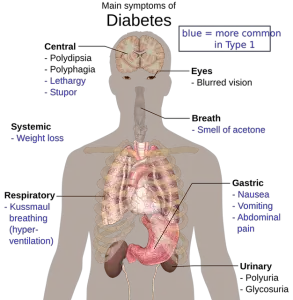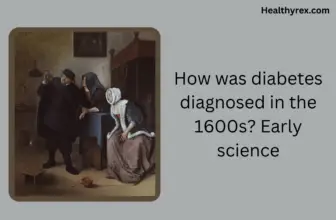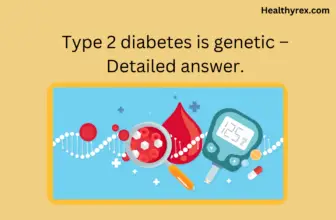Can type 1 Diabetes Turn Into Type 2?

Diabetes is a chronic disease associated with abnormally high levels of sugar (glucose) in the blood. These increasing glucose levels cause many life-threatening consequences. But a diabetic can lead a normal life through early diagnosis and effective management.
First of all, The most common types of diabetes are Two: insulin-dependent (type 1) and non-insulin dependent (type 2). These Type 1 and type 2 diabetes are distinct, their etiologies are also different.
So patients with Type 1 diabetes cannot turn into Type 2. But one person can manifest both types which are really rare. Diabetes occurs due to either the pancreas not producing enough insulin or the cells of the body not responding properly to the insulin produced.
Type 1 Diabetes
It occurs due to Autoimmune disease of the pancreas (the immune systems unable to recognize ‘self’ and destroys the beta cells which produce insulin). Common symptoms are frequent urination, increased thirst, increased hunger, and weight loss.
It is usually diagnosed in children and young adults, although it can appear at any age. People with type 1 diabetes mellitus need to take insulin every day. There is a subtype of type 1 known as LADA (latent autoimmune Diabetes in Adults) which is referred to as Type 1.5 diabetes. Type 1.5 has a slow onset like type 2 but it is an autoimmune disease like the type.
Type 2 Diabetes
It is characterized by high blood sugar, insulin resistance. Common symptoms include increased thirst, frequent urination, and unexplained weight loss. Primarily it occurs as a result of obesity and lack of exercise. There are some genetic factors also.
The genetic markers for Type 2 located on chromosome 2 on the human genome. As type 2 diabetes gets worse, the pancreas may make less and less insulin. This is called insulin deficiency.
Gestational Diabetes
Another important type is Gestational diabetes that develops when a person is pregnant. Most of them will not have had any diabetes before. It resolves after the birth of the baby.
Once a woman has had gestational diabetes, the individual’s risk of developing type 2 diabetes increases sevenfold. The women may also develop gestational diabetes in future pregnancies. Here a question may arise in your mind who is more likely to get the adverse effect of Gestational diabetes? Gestational diabetes is more of a risk for the baby than the mother.
Baby might have unusual weight gain before birth, trouble breathing at birth, or a higher risk of obesity and diabetes later in life. The mother might need a cesarean section because of an overly large baby, or she might have damage to her heart, kidney, nerves, and eyes.
Can type 1 Diabetes Turn Into Type 2?
Although the sign symptoms and complications of Type 1& Type 2 are the same, their mechanism of development is completely different.Type1 occurs due to autoimmune disease. That means they destroy their Beta-cell erroneously. Therefore, the lack of insulin happens. The body needs external glucose implementation for balancing blood glucose levels.
On the other hand, in case of type 2 Insulin present in the body but the body can not use it as body fat, the liver doesn’t pay any heed to the signal of insulin. Since their etiology and process of development are different so it is quite impossible for the conversation. Misdiagnosis may take place but that doesn’t mean they can convert into one another.
Can You Have Type 1 and Type 2 Diabetes at The Same Time?
There is a condition, that for a short while, termed as ‘Type 1 diabetes with insulin resistance’. People with type 1 diabetes who had a family history of type 2 were more likely to get overweight and insulin resistance. While Type 1 Diabetic can become insulin resistant due to taking larger doses of injected insulin to reduce the blood glucose level. So the two types can occur simultaneously. But type 2 cannot be turned into type 1.
You may be thinking then which one is more dangerous? Many of the health problems that can come with type 2. Because of damage to the tiny blood vessels in your (eyes) called diabetic retinopathy, (nerves) diabetic neuropathy, and (kidneys) diabetic nephropathy. They also have a higher risk of heart disease and stroke.
Can Type 2 Diabetes Become Insulin-Dependent?
Since Type 2 diabetes is most common amongst the type, it is possible that doctors may have diagnosis omission. A patient who is previously known as type 2 patient may be diagnosed with type 1 later. That doesn’t mean that type 2 diabetes is converted to type1. Their complications are similar but onset is different. On may not convert to another overnight.
Myths about Type 2 diabetes
As I mentioned some facts like type 2 are associated with weight gain and it usually occurs in older age. But it’s increasing in the younger population, due to shifts in diet, activity levels and higher rates of obesity. Now, You must be thinking that if you eat too much sugar in your younger days, that will develop type 2 diabetes?
Well, the answer is no! Eating too much sugar itself might not cause diabetes in early adulthood. But, eating excessive calories and sugar can lead to an increase in weight that can result in insulin resistance, which could then result in diabetes.
There is another myth, people having type 2 most often think that they no longer can take most foods. For them, they can still enjoy bread, pasta, and dessert. But The difference is about frequency and quantity.
What Happens if the Cells Don’t Respond Properly?
We all know that the body’s main energy blood glucose comes from the food we eat. Insulin is a hormone made by the pancreas. It helps glucose to enter into the cells which are used for energy. But sometimes our body is unable to make enough insulin or doesn’t use insulin well. Glucose then stays in the blood and doesn’t reach the cells and causes health problems.
- Read this article to know How Sugar Balance helps you to manage healthy blood sugar levels.
Risk Factors of Type 2 Diabetes
Certain factors are responsible for developing Diabetes include :
- Weight: the main risk factor for type 2 is overweight. However, you don’t have to be overweight to develop type 2 diabetes.
- Age: The risk of type 1 diabetes increases at a younger age but In the case of Type 2 it occurs in older age. That’s probably because people tend to involve in less physical activity. But type 2 diabetes is also increasing in the younger generation.
- Distribution of fat: Storing fat in the abdomen is more likely to develop diabetes(mainly type 2) than elsewhere in lips, thigh.
- Less physical activity: Physical activity helps you control your weight, uses up glucose as energy and makes your cells more sensitive to insulin. but inactive increases the chance of diabetes.
- Family history: Having a parent or sibling with type 1 diabetes increases the risk of developing diabetes.
- Diet: Eating more saturated fat and carbohydrates consider as a risk factor of diabetes.
Can Type 2 Diabetes Kill You?
It affects the vital organs of the body including the brain, heart, kidney. The complications of this organ lead to death. To avoid this you must go through the complications in detail.
- In heart: Diabetic patients usually unable to control their blood glucose level due to insulin resistance and some other reasons. Insulin resistance works as a risk factor for hypertension.so when both diseases come concurrently cardiovascular disease develops.
- In Brain: Glucose is the main fuel of Brain. But in type 1 diabetes there is a lack of insulin that causes a low level of insulin to enter into the cell which is very risky. It also affects the tiny blood vessels of the brain and the white matter. That results in vascular cognitive impairment.
- In the eye: Hyperglycemia is the most causative factor for developing ophthalmic complications. The main affecting site is retina & cornea. It causes diabetic retinopathy which is an inflammatory disease at the same time it is the main reason for blindness in a diabetic patient. Hyperglycemia is also responsible for epithelial dysfunctions of the corneal surface which ultimately results in loss of corneal sensation.
- In kidneys: we all know now that blood glucose plays an important role in maintaining the body’s blood pressure. But due to imbalance in glucose level, it damages blood vessels of different organs including kidneys.kidneys also help to regulate blood pressure. If diabetes is left untreated diabetic nephropathy may develop.
- In liver: people having diabetes more like to develop nonalcoholic fatty liver disease.

Diagnosis of Diabetes:
For proper diagnosis one must have followed the WHO criteria:
Glycated hemoglobin (A1C) test:
This is mainly a blood test that Doesn’t need fasting. An A1C level of 6.5 percent or higher on two separate tests indicates that you have diabetes. An A1C between 5.7 and 6.4 percent indicates prediabetes. Below 5.7 is considered normal.
Random blood sugar test:
Here, the blood sample will be taken at random times. Regardless of when you last ate, a random blood sugar 11.1 millimoles per liter (mmol/L) — or higher suggests diabetes.
Fasting blood sugar test:
Here, overnight fasting is necessary to take the blood sample. A fasting blood sugar level of less than 5.6 mmol/L is normal. A fasting blood sugar level from 5.6 to 6.9 mmol/L is considered prediabetes. If it’s 7 mmol/L or higher on two separate tests, you have diabetes.
Oral glucose tolerance test:
For this test, you fast overnight, and the fasting blood sugar level is measured. Then you drink a sugary liquid(glucose), and blood sugar levels are tested periodically for the next two hours.
A blood sugar level of less than 7.8 mmol/L is normal. A reading of more than 11.1 mmol/L after two hours indicates diabetes. A reading between 7.8 mmol/L and 11.0 mmol/L indicates prediabetes.
Prevention
There is a saying that prevention is better than cure. There is no other alternative than awareness. One can lead a healthy life by healthy eating and doing physical activities. Also, you have to avoid weight gain, sedentary lifestyle, smoking, saturated fat & carbohydrates consuming.
How are Type 1 and 2 Diabetes Treated?
There’s no cure for type 1 diabetes. They must inject insulin regularly into their body. The site of injections is into the soft tissue, such as the stomach, arm, or buttocks, several times per day. You can use insulin pumps. Insulin pumps supply a steady amount of insulin into the body through a small tube. Another essential part of Managing type 1 is regular blood sugar monitoring.
Type 2 diabetes can be controlled and even invalidated with diet and exercise alone. But it may not be enough for you. You must consult with your doctor and follow their guidance.
Conclusion
People in general, with diabetes, either have a total lack of insulin (type 1 diabetes) or they have too little insulin or cannot use insulin effectively (type 2 diabetes). Both types of diabetes increase the risk for a person as the type1 eventually turns into type2 diabetes.
However, healthy lifestyle choices can help prevent type 2 diabetes. That’s true even if you have diabetes in your family. If you’ve already received a diagnosis of diabetes, you can use healthy lifestyle choices to help prevent complications. If you have prediabetes, lifestyle changes can slow or stop the progression of diabetes.
FAQ About Diabetes
1. What is the difference between Type 1 diabetes and Type 2?
| Type 1 diabetes | Type2 diabetes |
| 1.onset at an early age (<20years). | 1.gradual onset at an older age(>30years) |
|
2.Normal weight. |
2.Obesity |
| 3.decreased blood insulin. | 3.Normal or increase blood insulin |
| 4.presence of anti-islet cell antibodies | 4.No anti-islet cell antibodies present |
| 5. Therapy: insulin invariably | 5.Therapy: oral hypoglycemic agent |
2. What is Worse Type 1 or Type 2?
Type 2 diabetes is a progressive condition. In type 2 diabetes, the body is unable to use insulin the right way. As a result, insulin resistance develops. So, it gets worse over time but can be reversed through proper medication and lifestyle modification. But Type 1 is totally untreatable. So type 1 is worse.
3. Can Type 1 Diabetes be Reversed?
Type 1 diabetes is an autoimmune disease. It has no cure but early diagnosis and proper medication help for cessation. Yet, A case study suggests that type 1 can be reversed by a plant-based diet.
4. Can Type 2 diabetes go away?
The term ‘go away’ is used when people can go off medications. Is it possible in type 2? Well, Type 2 is an ongoing disease and there’s no cure for it. At the same time, studies show it’s possible for some people to reverse it through diet changes and weight loss. By this, you may be able to hold normal blood sugar levels without medication.
Read what to do if your blood sugar won’t stay up.






